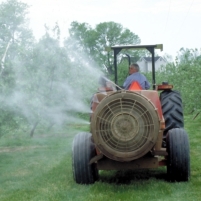USDA Report: Apples Most Often Contain Pesticides; Onions Safest
Wednesday, June 29, 2011
 Apple spraying (photo: University of Kentucky)
Apple spraying (photo: University of Kentucky)
An apple a day can keep the doctor away, as long as it’s not heavily contaminated with pesticides.
America’s second most popular fresh fruit (behind bananas) is nearly always sold with some amount of farm chemicals on it, according to the Environmental Working Group (EWG), which has published its latest shopper’s guide to inform consumers which vegetables and fruits are safest (and riskiest) to eat.
Ninety-eight percent of apples tested by the U.S. Department of Agriculture (USDA) were found to contain pesticide residue, says the EWG. In most cases, though, the contamination was small and considered safe to consume based on federal standards.
Nevertheless, the EWG placed apples at the top of its “Dirty Dozen” list, which included grapes, strawberries, cilantro, potatoes, oranges and spinach, because 90% of their samples tested positive for pesticide.
At the other end of the testing spectrum is the “Clean 15,” composed of produce that was found to have very little contamination. Topping this list were onions, sweet corn, pineapples, avocados and asparagus.
The popular herb known as cilantro or coriander scored a dubious record in the USDA study, as analysis detected the use on the plant of 33 different kinds of unapproved pesticides.
-Noel Brinkerhoff
Pesticide Residues: The Dirty Dozen (CASFS Blog & Forum)
Apples Found to Contain the Most Pesticide Residue (by Samantha Bonar, LA Weekly)
Executive Summary (EWG’s 2011 Shopper’s Guide)
The Full List: 53 Fruits and Veggies (Environmental Working Group)
- Top Stories
- Unusual News
- Where is the Money Going?
- Controversies
- U.S. and the World
- Appointments and Resignations
- Latest News
- Trump to Stop Deportations If…
- Trump Denounces World Series
- What If China Invaded the United States?
- Donald Trump Has a Mental Health Problem and It Has a Name
- Trump Goes on Renaming Frenzy






Comments